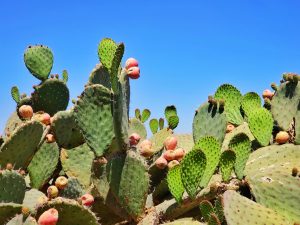
Why must cacti be your first plant?
Alejandra Roldán and Dr. Amaranta Arellano answer the question “Why must cacti be your first plant?”
The Cactaceae (Cactaceae) are a plant family that belong to the order Caryophylalles. They are native to the American continent and Mexico has almost 50% of all existing species.
They have a great value in Mexican culture and an ornamental relevance, because when flowering, cacti generate a dynamic of colors in themselves, which, when placed together, evokes a Mexican landscape, energetic and colorful. In addition, in the cacti you can also find cochineals, an insect that inhabits the nopales and from which color can be subtracted for textiles.

Cacti garden
Photography: Chris Chatham in Unsplash
At the same time it has a great gastronomic weight, since nopales are indispensable in many Mexican dishes.
On National Cacti Day it is essential to know these facts, as well as the plant care, but did you know that cacti are easy to maintain and you can easily adapt them to your home?

Edible cactus.
Photography: Daniel Lloyd Blunk-Fernández in Unsplash
Below, I will list the benefits and the reasons why you can adapt a cactus and later have a cacti garden.
- They adapt very well to direct light, so they can be placed in direct sun or indoors in a place where there is considerable sunlight.
- Cactaceae do not require daily watering, as they adapt very well to sites with low humidity, however, you should observe the soil in which it is placed and check if it is very dry, in that case it will require water.
- They are species that conserve water very well, mainly in their stems, as these are fleshy.

Rebutia.
Photography: Leonora Enking via Creative Commons. CC BY-SA 2.0
- The conservation of water in the stems is due to the fact that cacti are species that do not contain leaves, instead they have spines that emerge from the areoles, which represent a strategy to conserve water in the cacti.
- They are attractive to pollinators thanks to the rewards offered by their flowers such as pollen and nectar, ranging from bees and hummingbirds to bats.
- They exhibit resistance to disease and pests, as long as they have adequate ventilation.
- Maintaining a cacti garden provides multiple ecosystem benefits and natural wealth, since urban birds and reptiles can approach them to feed on their fruits or pollinate, generating micro landscapes in our homes or buildings.
Cacti are species that can easily adapt to our homes and lifestyle, and there are certain species that, because they have few thorns, tolerate more shade.

Echinocactus.
Photography via pxhere CC0 public domain.
Here are some species that you can adapt to sun and/or shade.
For direct/all day long sun, you need cacti with many spines such as Ferocactus: Ferocactus stainesii, Ferocactus pottsii, Ferocactus fordii and Echinocactus are also ideal. While for shade or spaces where there is a lack of light, the genre Rebutia is excellent, as well as all species belonging to the genus Schlumbergera, which do not even need direct light.

Cactis.
Photography: Miguel Urieta in Unsplash
To start taking care of plant species implies a great responsibility because to be able to give them the necessary care you must know the general characteristics that will define their behavior, but, having them in our homes involves a double work when analyzing which are the adequate spaces for our species to grow.
Cacti are easy to adapt to our spaces, but despite this we must not forget that we must give them care and attention to have better results, and also that they are species that represent an entire continent and many of them are endangered, so by taking care of some of them we generate a positive impact on the environment.

Cactis in greenhouse.
Photography: Chelsea Bock in Unsplash
Bibliografía:
- BBC Gardeners World Magazine. 10 succulents for shade. BBC Gardeners World Magazine.https://www.gardenersworld.com/how-to/grow-plants/10-succulents-for-shade/. (Consultado el 4-10-2023).
- Comisión Nacional de Áreas Naturales Protegidas. ‘’Día Nacional de las Cactáceas.’’ Comisión Nacional de Áreas Naturales Protegidas. https://www.gob.mx/conanp/articulos/cactaceas. (Consultado el 4-10-2023)
- Durán Rafael y Méndez Martha ‘’Cactáceas.’’ Biodiversidad y Desarrollo Humano en Yucatán.https://www.cicy.mx/Documentos/CICY/Sitios/Biodiversidad/pdfs/Cap4/17%20Cactaceas.pdf. (Consultado el 4-10-2023)
- Diversidad Vegetal- Facultad de Ciencias Exactas y Naturales y Agrimensura. ‘’Familia Cactácea.’’ UNNE. https://exa.unne.edu.ar/biologia/diversidadv/documentos/ANGIOSPERMAS/Core%20Eudicotiled%F3neas%20Basales/Cactaceae.pdf (Consultado el 4-10-2023)
- Guerrero Belinda. ‘’CÓMO CUIDAR LOS CACTUS: CARACTERÍSTICAS, VARIEDADES Y RIEGO.’’ micasa. https://www.micasarevista.com/plantas-flores/g21149762/cactus-cuidados-consejos-tipos/ (Consultado el 4-10-2023)
- PATCH. ‘’Complete guide to cactus care.’’ PATCH. https://www.patchplants.com/gb/en/read/plant-care/complete-guide-to-cactus-care/ (Consultado el 4-10-2023)
- Secretaría de Medio Ambiente y Recursos Naturales. ‘’Cactáceas, riqueza natural de México.’’ Secretaría de Medio Ambiente y Recursos Naturales. https://www.gob.mx/semarnat/articulos/cactaceas-riqueza-natural-de-mexico#:~:text=En%20M%C3%A9xico%2C%20las%20cact%C3%A1ceas%20se,propios%20o%20exclusivos%20del%20pa%C3%ADs. (Consultado el 4-10-2023)
- Universidad Autónoma de Ciudad Juárez. Instituto de Ciencias Biomédicas Programa de Biología. Importancia de las Cactáceas. Hoja Técnica de Divulgación Científica No. 13. Agosto-Diciembre 2017. https://www.uacj.mx/ICB/UEB/documentos/13.%20CACTACEAS.pdf (Consultado el 4 de octubre de 2023)











